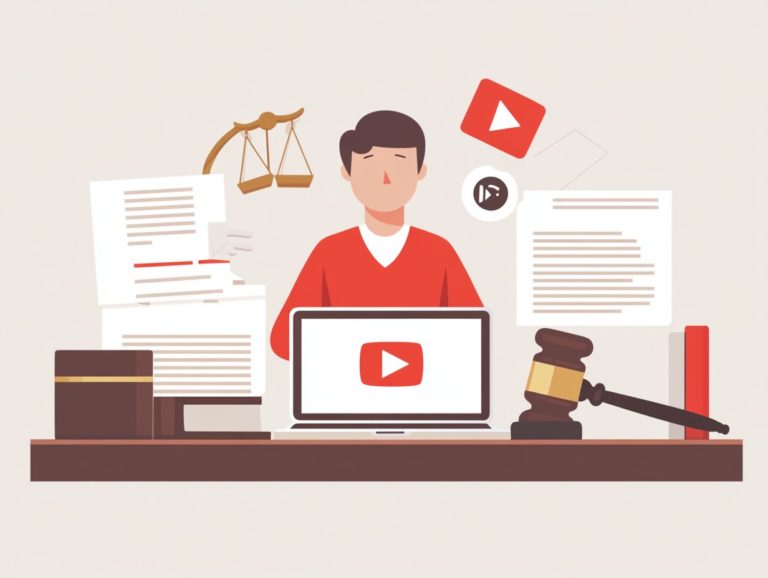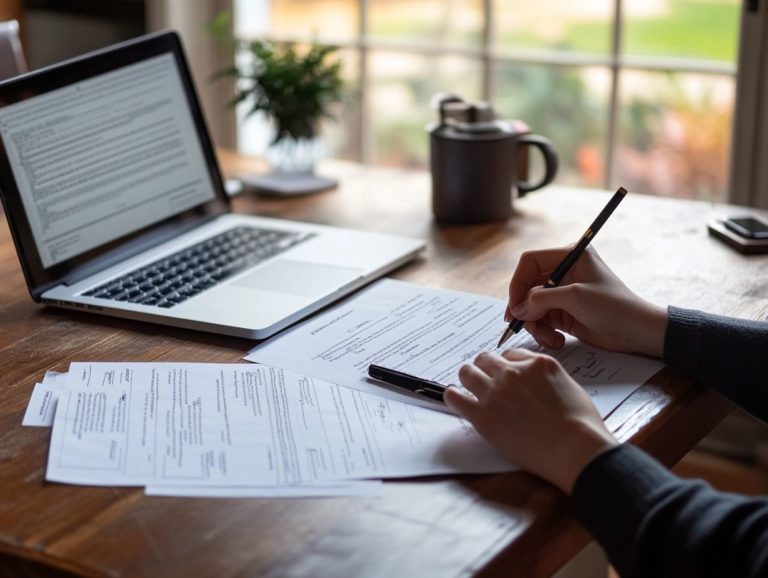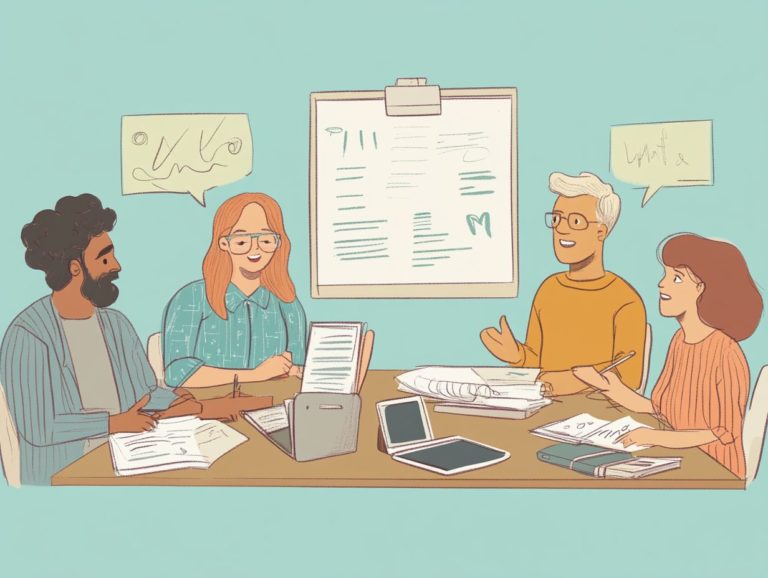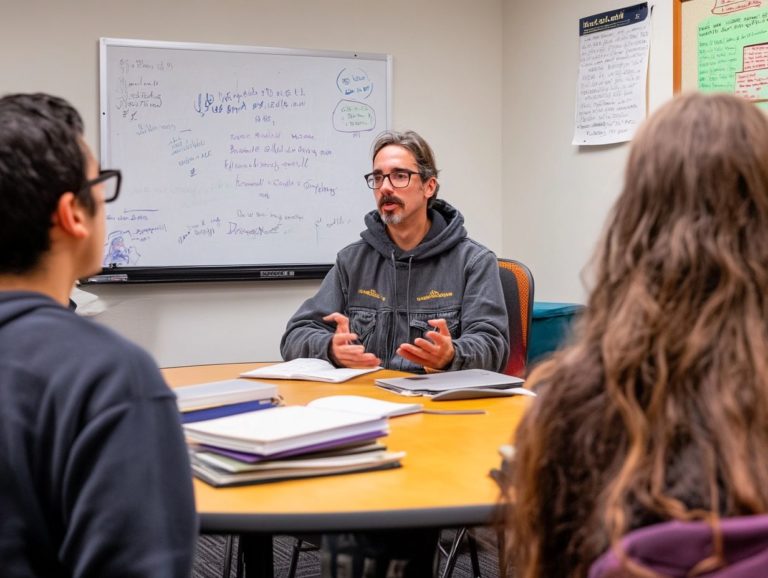How to Register a Copyright: A Step-by-Step Guide
Copyright law is essential for safeguarding the creative works that enrich our culture, including literature, music, art, and technology.
Going through the registration process might seem daunting, but it doesn’t have to be an uphill battle.
This article provides a clear, step-by-step guide on how to register your copyright, addressing everything from determining your eligibility to submitting your application.
You ll discover the advantages of copyright protection and key considerations for upholding your rights.
Whether you re a seasoned creator or just starting your creative journey, this guide is designed to empower you in effectively protecting your work.
Contents
- Key Takeaways:
- Understanding Copyright Law
- Step 1: Determine if Your Work is Eligible for Copyright
- Originality and Fixation Requirements
- Step 2: Gather Necessary Materials
- Required Documents and Information
- Step 3: Complete the Registration Application
- Filing Options and Fees
- Step 4: Submit Your Application
- Step 5: Wait for Processing and Confirmation
- Additional Considerations
- Frequently Asked Questions
- 1. What is a copyright and why should I register it?
- 2. How do I determine if my work is eligible for copyright protection?
- 3. Can I register a copyright for multiple works at once?
- 4. How do I register a copyright for my work?
- 5. How long does the registration process typically take?
- 6. Is it necessary to hire a lawyer to register my copyright?
Key Takeaways:
- Copyright provides creators with legal protections and benefits for their original works.
- Before registering, ensure your work is original and in a physical form, such as a digital file or painting, and have necessary materials ready.
- Choose the appropriate filing option and submit your application to acquire copyright protection.
Understanding Copyright Law
Understanding copyright law is crucial for you as a creator aiming to safeguard your original work. Copyright law includes important rights that protect your art, music, and writing, ensuring that you maintain exclusive control over your creations.
Don’t wait! Securing legal protection against infringement is crucial. Familiarity with pertinent laws, including the Copyright Act of 1976 and the Digital Millennium Copyright Act, equips you to navigate the complexities of copyright in our digital era.
What is Copyright?
Copyright is a legal term that gives you exclusive rights to your original works, covering a wide array of creative expressions, including art, music, literature, and digital content. This legal framework gives you the power be you an author, artist, or musician to maintain control over how your creations are used, reproduced, and distributed, ultimately allowing you to reap financial rewards from your hard work.
The protection offered by copyright spans various mediums, such as paintings, photographs, novels, films, and even intricate software code. With copyright, you gain exclusive rights that include the ability to copy your work, create derivative versions, and publicly perform or display it.
The significance of copyright protection is immense, as it cultivates innovation and creativity in industries reliant on original ideas. It serves as a safeguard against unauthorized use, ensuring that you receive the recognition and rewards you deserve for your contributions.
Benefits and Protections
The benefits of copyright are extensive, offering you robust legal protection against infringement. This gives you the power to control how your original works are used and to monetize them in a meaningful way. With copyright, you also gain the opportunity to license your creations, opening the door to passive income through royalties whenever others utilize your intellectual property. This system nurtures a sustainable creative economy and encourages you, as an artist or innovator, to invest your time and resources into new projects without hesitation.
Registering your copyright is a vital step in strengthening these protections, especially in today’s digital landscape, where unauthorized use is all too common. By clearly documenting your ownership, you position yourself to take decisive action against infringement, ensuring your interests are protected.
Step 1: Determine if Your Work is Eligible for Copyright
Before you embark on registering your copyright, it s essential to ascertain whether your work aligns with the eligibility criteria established by copyright law. This means your creation must be an original piece and fixed in a tangible medium of expression, such as a digital file or a physical artwork.
Originality and Fixation Requirements
The originality and fixation requirements are essential in copyright law. For your work to be protected, it must be an original work written or recorded in some way, reflecting your unique expression of ideas.
These criteria serve as benchmarks in determining whether your creative work qualifies for legal protection. Originality demands a certain level of creativity that sets your work apart, while fixation requires that your creation be recorded in a physical form, such as written manuscripts or digital files.
As digital technologies advance, they influence how these principles are applied in copyright claims. For instance, a digitally created artwork, like generative art, can still meet the originality standard, even if it consists of algorithmic patterns. Similarly, using music samples in digital compositions shows how originality can emerge from remixing established works, stretching traditional definitions.
Step 2: Gather Necessary Materials

To register your copyright successfully, you need to compile essential materials. This includes the copyright application, which details your original work and any necessary documents to support your claim.
Required Documents and Information
You typically need a completed application form, a copy of your original work, and a filing fee for a copyright application. These elements are crucial for a smooth registration process.
Beyond these basics, familiarize yourself with the specific requirements related to the type of work you re submitting. If you re dealing with artistic expressions like paintings or sculptures, you may need to provide high-resolution photographs. Literary works often require a properly formatted manuscript. Digital content creators should submit a representative file that showcases their work accurately.
Researching the guidelines set by copyright offices is vital to avoid delays, ensuring that your submissions are complete and well-prepared.
Step 3: Complete the Registration Application
Completing the registration application is vital for securing copyright protection for your work. You need to provide detailed information about your original creation and pay the required filing fee.
This step protects your valuable creations, allowing you to maintain control over your creative endeavors.
Filing Options and Fees
When registering for copyright, you ll find various filing options and associated fees that can fluctuate based on your chosen method and the type of work you’re submitting.
Online filing offers a streamlined experience, often featuring lower fees and faster processing times than traditional mail submissions. The U.S. Copyright Office s online system is user-friendly, allowing you to upload your works easily.
If you prefer physical copies, you can submit via mail, but you ll need to factor in additional costs, such as postage. Understanding the fee structure is crucial; while standard applications generally have a fixed rate, you may benefit from reduced fees for specific categories, such as small entities or individual creators.
Explore fee waivers for qualifying organizations to save money, making the registration process more accessible for emerging artists like you.
Step 4: Submit Your Application
Submitting your copyright application marks the final step in the registration process. This is your chance to send your carefully completed application package to the U.S. Copyright Office, whether you choose online registration or traditional mail.
Online, Mail, or Hand Delivery
When you submit your copyright application, you have several options: online registration, mail delivery, and hand delivery to the U.S. Copyright Office. Each method has its own advantages and processing times.
Understanding these methods is essential for a smooth application process. Online registration is often the most efficient choice, allowing you to complete everything quickly and securely from home often leading to faster processing times.
Traditional mail may take longer because of possible postal delays. However, it can be preferable if you want physical documentation for your records.
As you weigh your options, consider your urgency, comfort level with technology, and whether you need tangible proof of your submission. Tailoring your approach to your needs can greatly enhance your experience.
Step 5: Wait for Processing and Confirmation

Once you ve submitted your copyright application, the next step is to patiently await processing and confirmation from the U.S. Copyright Office.
This period can extend over several months, depending on their current workload and the complexities of your application.
Timeline and Next Steps
The timeline for copyright registration can vary, usually taking several months before you receive confirmation. During this time, it s vital to stay informed about the next steps to protect your work.
While you wait, keep a close watch on the marketplace for any signs of potential copyright infringement. Acting quickly can help you spot unauthorized uses of your creations.
Making a plan for enforcing your rights should be a top priority. This involves documenting potential infringements and gathering evidence to support your case, ensuring you re prepared to take legal action once your registration is confirmed.
Taking action to protect your work not only secures your rights but also empowers you as a creator.
Additional Considerations
While navigating the U.S. copyright registration process, you should also consider international copyright protection.
It’s important to understand the significance of renewing and maintaining your copyright to ensure continued legal protection for your original works.
International Copyright Protection
International copyright protection is crucial for creators aiming to safeguard their works across borders. It s governed by treaties and agreements that facilitate the recognition of copyright in various countries.
Treaties like the Berne Convention an international agreement that helps protect your copyrights in different countries lay down fundamental principles for copyright enforcement. They guarantee that you enjoy your rights in every member state if you meet a minimum standard of protection.
The importance of these agreements is immense; they empower you to retain ownership and control over your work, no matter where it s used.
To strengthen your copyright position, it s vital for you whether as an individual or a business to devise strategies for securing your original creations internationally. This might include registering your works in multiple jurisdictions and actively monitoring their use.
Engaging with legal experts who specialize in international laws can be invaluable. Their expertise helps you navigate these complexities, ensuring that your copyrights are thoroughly protected.
Renewing and Maintaining Your Copyright
Renewing and maintaining your copyright is essential for ensuring that your original works remain legally protected. Remember, copyright doesn t last forever; it has a finite duration that may require renewal or reassessment.
To understand how to renew your copyright easily, you need to be aware of specific timelines and requirements, which can differ depending on your location. It’s smart to submit your renewal applications well ahead of the expiration date often within a year before it lapses.
Missing the renewal deadline could mean losing your exclusive rights, allowing others to use your work without your permission. Thus, it s crucial to keep meticulous records of all relevant documentation and deadlines. This diligence ultimately protects your creative endeavors from unauthorized use or exploitation. Act quickly to ensure your rights stay protected!
Frequently Asked Questions
1. What is a copyright and why should I register it?

A copyright is a legal protection granted to creators of original works, such as books, music, or artwork. Registering your copyright provides you with legal evidence of ownership and the ability to take legal action against anyone who uses your work without permission.
2. How do I determine if my work is eligible for copyright protection?
To be eligible for copyright protection, your work must be original and fixed in a tangible form. This means you need to have your work in a physical or digital format, such as a written manuscript or recorded song.
3. Can I register a copyright for multiple works at once?
Yes, you can register a group of unpublished works or a collection of published works under a single copyright registration. This is known as a “group registration” and can save you time and money.
4. How do I register a copyright for my work?
To register a copyright, you must submit an application to the United States Copyright Office. This can be done online or by mail. You will need to provide a copy of your work, the title, and the names of any other contributors, if applicable, which is part of the copyright registration process.
5. How long does the registration process typically take?
The processing time for copyright registration can vary, but it typically takes around 3-8 months. If there are any errors or missing information in your application, it may take longer. Make sure your application is complete and accurate to speed up the process!
6. Is it necessary to hire a lawyer to register my copyright?
No, it is not necessary to hire a lawyer to register your copyright. However, seeking legal advice can be helpful in understanding the copyright registration process and protecting your rights as a creator. You can also seek assistance from the Copyright Office or use online resources to guide you through the process.






